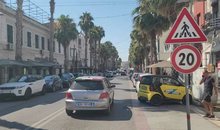
 Flash News
Flash News
Accident at "Shkalla e Tujanit", truck overturns in the middle of the road, driver injured
Vlora by-pass, work delays and cost increases
Milan are expected to give up on the transfer of Granit Xhaka
Inceneratori jashtë funksionit, përfshihet nga flakët fusha e mbetjeve në Elbasan
Accident on the Lezhë-Shëngjin axis, one injured
PRINT / Ease to break in Tirana: 'Modern' mentality, so ingrained in provincialism ...

from LEKË TASI
This article is part of the new section "PRINT" opened by Politiko.al with materials taken from the funds of the Periodical and the Book of the National Library. Published in the newspaper "RD", Tuesday, April 4, 1995, p. 5.
Those who still keep alive the memory of old Tirana are decreasing daily over the years. This is natural, but their silent complaint about the violent transformation that their beloved city underwent remains appropriate.
When we went down to the street "28 Nëndori" we met in the hardware store of Haxhi Duda, where we gathered every end of August to be supplied with school supplies ... then we continue inside that old market of hundreds of shops and dozens of crafts, full of noise, names, voices, colors, types, events, and above all with the feeling of free initiative, life flourished ... A series of experiences that have left an indelible impression on my conscience. No matter how hard we try to put them in their kiosk-filled space now, we will not succeed.
This space has included something precious and dear to our lives. But the damage that results from sudden frustration goes far beyond the dimensions of common dissatisfaction with the change that time brings.
HOW WAS IT...?
The plan of the Old Bazaar resembled an irregular trapezoid, bordered by Skënderbej Square and the three main streets of the center: 28 Nëndori, Mbretnore, and Dibra. You entered it by means of six narrow streets, paved with solid cobblestones. If conceived with creative ingenuity, it could lead us to the configuration of two Tirana, one hearth of trade and traditional handicrafts, the other around it open for rapid and contemporary development. A contrast that has given original results everywhere in the world, with very interesting solutions.
With the local color of the typical Balkan city and the economic efficiency, we joined in this market that a unity that underwent the development of the time.
. gain the awareness that you were at the center of the country, not only geographically, but organically, because there the lines of economic force were felt in all directions.
HOW DID IT DISAPPEAR ...?
We had the duty to preserve this economic-cultural area with our living tradition, to keep these areas everywhere in Albania, already extinct, or partially preserved as lifeless waste. It was the duty of the intellectuals to come to the defense of the Old Bazaar of Shkodra with Bezistan in the middle, the port above Buna to be restored after the earthquake to be hit artistically. The Old Bazaar of Lezha with its narrow medieval alleys, the historic one of Përmet, and every other market up to the smallest centers. And not only for their picturesque and cultural-historical side, but also for the modern economy to be established there first, utilizing the material basis and especially the human experience.
The disappearance of the Old Bazaar of Tirana directly from above, in addition to the devastating blow it dealt to trade and handicrafts, brought an unprecedented social upheaval. A large number of skilled craftsmen left the production center on the muddy outskirts of factories and congenital plants - the old.
With this radical erasure that happened everywhere in us, the chronicle and history are deprived of the opportunity to be created later and to be connected with the generations to come. And it is only a matter of some of the acts of this unstoppable decay, of not being able to prove that we are more ancient.
And here, we have in mind the current landscape of the Old Bazaar of Tirana now let's see its urban side. The center did not get the expected optimal solution at all with the disappearance of the Old Bazaar, however inappropriate this statement may seem to the supporters of socialist cosmopolitanism. The leveling of the communist government could give way to level projects. But along with this approval to compete while preserving what existed there. But he did not. We do not know how many declared followers there was an option for the Old Bazaar to be preserved. If there were, they must have been extremely disarmed. The defense of the old (even when it was called a tradition) required clear, economic motivation, and this contradicted the communist plan.
Every attempt at opposition was anticipated with the first legs. However, there were some that even came out with articles in the press, but with consequences for the authors, later ...
The sacrifice of the elders across the country happened very easily, not because the intelligence was blunted by the violence of authority, but because it was violated was sidelined by its elite who stood close to the power and wanted to climb even closer to it, releasing without resistance any which was required of him. It is this cause that narrowed the space of discussion to asphyxiation even for technical problems. Even today, the former official intelligence, adopting the attack as the most effective defense, insists on presenting its long burial work as filled with unsurpassed successes.
HOW WILL IT BECOME ...?
What physiognomy could the Old Bazaar take if it existed today? Let us not forget first of all that any restoration in archeology and paleontology, starts enough to have a small part of the original stones or bones. This is how the feeling of the past was created. In the case of Tirana's Old Bazaar, more than that would happen. The base would be whole, the addition on that base would become insensitive because it would not remove anything that could stand, but by utilizing ideas and craftsmen, it would embellish to give not just a launched antique, but only that Shopping developed in time. It is enough to imagine the Bath (Hamam) of the beginning of the XVII century in operation according to the technical one, next to various shops that reflect the commercial life in all later stages, up to the contemporary one. Our craft, original and sought after for its diversity, it would have its most representative headquarters there, with traditional and new values. Souvenir lovers, foreign and domestic tourists, would find in the very center of the city, two steps away from the hotels, the goods they were looking for, within a historical atmosphere. Thus, the capital would become through this town with its center, a rare and worthy place to visit and not just a place to go to work. This precision, let's call it that, would in itself bring about high-quality works: the cobblestones would be rebuilt from scratch near the careful restoration of the shops. Ateliers of new items, up to those of luxury, would appear next to them. For the sake of this modernization, the whole archaic color of the crafts and trade of tradition would be preserved. Also restaurants, cafes,
This petty trade center would be surrounded in time by the tall street buildings that surround it, which today bear their old name. These buildings would keep the ground floor intact, to perpetuate the history and everything that deserves to be remembered, such as the shop of Mustafa Mara, imprisoned by Turkey for patriotic activity (distributed to the press, and for this, he was given the surname Drita from the title of the newspaper he was spreading) and that on November 26, 1912, he sewed in his shop many national flags with which he decorated the whole Bazaar on that day marked for the nation. His shop, which today can not even be determined where it was located would be in the showcase by the flag, near the fountains of gramophones that he was the first to import from Europe. Like this case, and plenty of others, from history.
This conservative-artistic spirit in dealing with every detail left by time would extend to the entire city center, regardless of the transformations that the years would bring. (This must be adopted strictly today with greater care, to lose at least what is left of us standing). As for the remark that a center with narrow streets would create problems for increasing traffic, it must be said that the benefits (even ecological) of this being in the center, not itself, which would not hinder but would facilitate by weight at least of it, in digging up an underground plan, not only for movement but also for utilities.
IN The End ...
To be objective, the tendency to spoil must be explained not only by the arrogant and malicious desire to destroy. Tirana - the capital got its physiognomy through adjustments made during the 20s and 30s. It became a city with straight and not very wide streets, which is connected to our image for it, and the excellent scheme of the Center where the rays are cut was more than hit. If this plan, established early on, was fully realized, anyone who would stand at a point on Skanderbeg Square could see the end of the eight roads that opened around the horizon. A feeling that can rarely be offered by a city in the world. Not only was it not realized,
The urban history of Tirana condensed in this way seems to us unlucky and betrayed by an absolute political power that mercilessly, for the sake of a completely ordinary solution, mercilessly deleted even the most important part of the city, the old one we want and have we need it today.
It must be said that the warm bed for this self-destruction also serves the mentality inclined towards modernity, as well as ingrained in provincialism: which considers these breakdowns not as great harm.
Today Tirana has started to stretch through the hills. With the economic power that our homeland will gain, it is certain that the suburbs will emerge tomorrow at a much higher level of construction than we had ever dreamed of. But it must never be forgotten that the preservation or adaptation of the old to the new, of the great to the small, must be a law that must be strictly enforced.
Latest news








Golem and Qerret without water at the peak of the tourist season
2025-07-01 21:09:32

Euractiv: Italy-Albania migrant deal faces biggest legal challenge yet
2025-07-01 20:53:38
BIRN: Brataj and Fevziu victims of a 'deepfake' on Facebook
2025-07-01 20:44:00

Vlora by-pass, work delays and cost increases
2025-07-01 20:24:29



Milan are expected to give up on the transfer of Granit Xhaka
2025-07-01 19:41:25


The silent but rapid fading of the towers' euphoria
2025-07-01 18:58:07
Donald Trump's daughter says 'goodbye' to June with photos from Vlora
2025-07-01 18:48:47

Tirana vote recount, Alimehmeti: CEC defended manipulation
2025-07-01 18:15:05

Left Flamurtari, striker signs with another Albanian club
2025-07-01 17:43:14
Accident on the Lezhë-Shëngjin axis, one injured
2025-07-01 17:19:35
June temperature records, Italy limits outdoor work
2025-07-01 17:03:15

Meet Kozeta Miliku, named one of the top five scientists in Canada
2025-07-01 16:32:12
"Arsonist" arrested for repeatedly setting fires in Vlora (NAME)
2025-07-01 16:29:45

The ecological integrity of the Vjosa River risks remaining on paper
2025-07-01 16:09:40
Heat Headache/ Causes, Symptoms and Measures You Should Take
2025-07-01 16:01:13
UN: The world must learn to live with heat waves
2025-07-01 15:54:50

Three cars collide in Tirana, one of them catches fire
2025-07-01 15:38:16

Shehu: Whoever doesn't want Berisha, doesn't want the opposition 'war'!
2025-07-01 15:19:20
Berisha requests the OSCE Assembly: Help my nation vote freely
2025-07-01 15:11:46
Be careful with medications: Some of them can harm your sex life
2025-07-01 15:00:32

'Golden Bullet'/ Lawyers leave the courtroom, Altin Ndoc's trial postponed again
2025-07-01 14:44:52
EU changes leadership, Kosovo in a number of places
2025-07-01 14:40:01
Should we drink a lot of water? Experts are surprised: You risk hyponatremia
2025-07-01 14:30:20



Lëpusha beyond Rama's postcards: A village that is being silently abandoned
2025-07-01 13:41:56
Scorching temperatures in France close the Eiffel Tower
2025-07-01 13:29:35
Media: China, Iran and North Korea, a threat to European security
2025-07-01 13:20:12
Albania drops in global index: Less calm, more insecure
2025-07-01 13:09:35
Road collapses, 5 villages in Martanesh risk being isolated
2025-07-01 13:03:04

Këlliçi: Opposition action to be decided in September
2025-07-01 12:48:49
Four tips for coping with the heat wave
2025-07-01 12:38:53
Car hits pedestrian on Transbalkan road
2025-07-01 12:27:09
Authors of 9 robberies, Erjon Sopoti and Abdullah Zyberi arrested
2025-07-01 12:15:56

He abused his minor daughter, this is a 36-year-old man in custody in Fier
2025-07-01 11:50:34
The constitution of the Kosovo Assembly fails for the 40th time
2025-07-01 11:40:08




EU confirms support for the Western Balkans
2025-07-01 10:50:45
Serious in Fier! Father sexually abuses his minor daughter
2025-07-01 10:32:33
One year since the passing of the colossus of Albanian literature, Ismail Kadare
2025-07-01 10:25:26


They supplied the 'spaçators' with drugs, two young men are arrested in Tirana
2025-07-01 09:54:09
Europe is "scorching", how dangerous are high temperatures?
2025-07-01 09:48:56


Nigel Farage in Albania: but why?
2025-07-01 09:13:12
Xama: The "Partizani" dossier is quite weak and without facts!
2025-07-01 09:04:47

Foreign exchange, the rate at which foreign currencies are sold and bought
2025-07-01 08:35:39
Fabricators again warn of factory closures and job cuts
2025-07-01 08:21:30
Horoscope, what do the stars have in store for you today?
2025-07-01 08:08:59
Scorching hot, temperatures reaching 40°C
2025-07-01 07:57:12
Morning Post/ In 2 lines: What mattered yesterday in Albania
2025-07-01 07:42:59
Recount after May 11, Braho: I had no expectations for massive vote trafficking
2025-06-30 22:54:18

Second hearing on the protected areas law, Zhupa: Unconstitutional and dangerous
2025-06-30 22:18:46



Israel-Iran conflict, Bushati: Albanians should be concerned
2025-06-30 21:32:42

Fuga: Journalism in Albania today in severe crisis
2025-06-30 21:07:11
"There is no room for panic"/ Moore: Serbia does not dare to attack Kosovo!
2025-06-30 20:49:53

Temperatures above 40 degrees, France closes nuclear plants and schools
2025-06-30 20:28:42
Lavrov: NATO is risking self-destruction with new military budget
2025-06-30 20:13:54
Turkey against the "Bektashi state" in Albania: Give up this idea!
2025-06-30 20:03:24

Accused of sexual abuse, producer Diddy awaits court decision
2025-06-30 19:40:44


